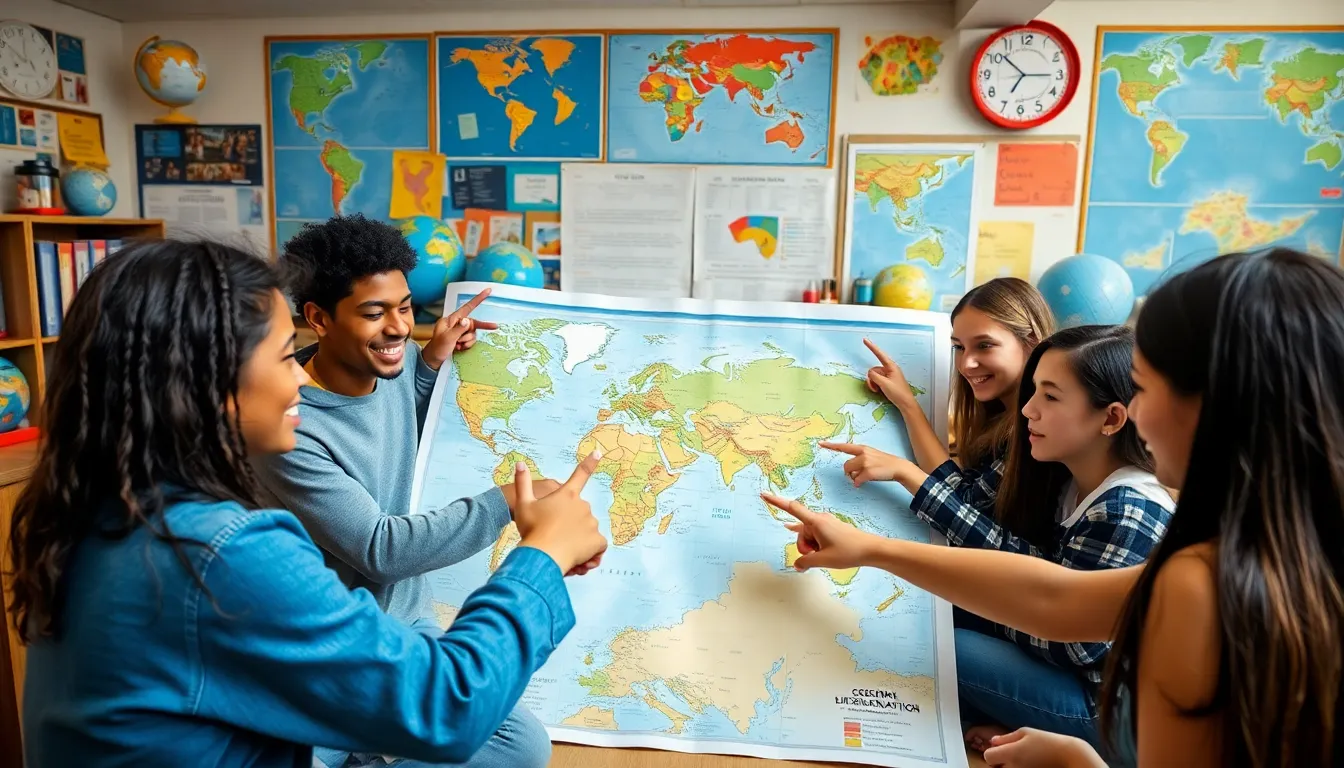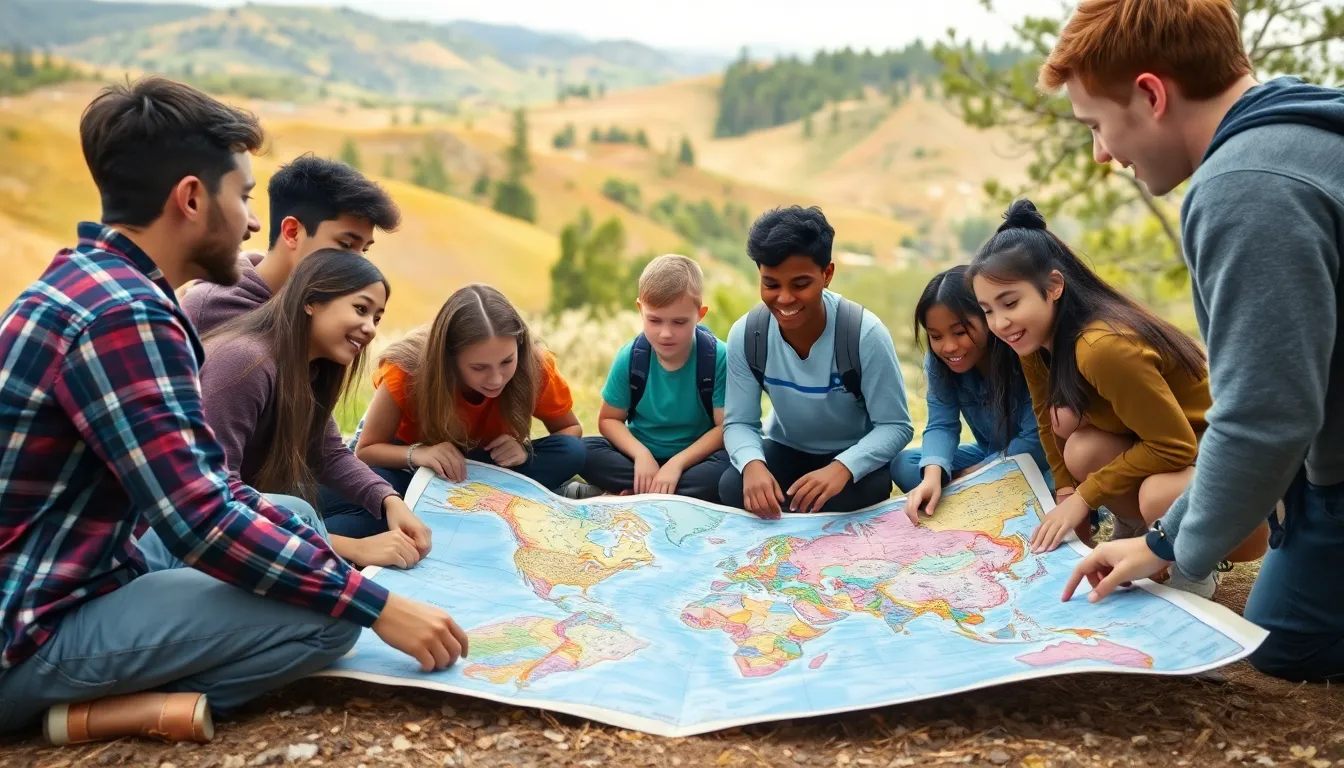High school geography isn’t just about memorizing capitals and rivers; it’s the ultimate adventure through our planet’s wonders. Imagine exploring the majestic mountains of the Himalayas or the vast deserts of the Sahara—all from the comfort of your classroom. It’s like a passport to the world without the pesky baggage fees.
Geography sparks curiosity and helps students understand the intricate web of cultures, climates, and ecosystems that shape our lives. Whether they’re plotting the path of a hurricane or analyzing the impact of urbanization, students gain valuable skills that go beyond the classroom. So why not dive into the fascinating world of geography? It’s not just a subject; it’s a journey that equips them with the knowledge to navigate both the globe and their futures.
Table of Contents
ToggleOverview of High School Geography
High school geography offers a comprehensive study of the Earth’s landscapes, environments, and the relationships between people and their environments. Students explore diverse topics such as physical geography, cultural geography, and human geography, gaining insights into Earth’s dynamic systems.
Physical geography covers natural features like mountains, rivers, and climate patterns. Understanding these elements helps students analyze how natural phenomena affect human activities and ecosystems. Human geography focuses on population, migration, and urbanization, revealing how cultures shape and are shaped by geographical contexts.
Maps serve as essential tools in geography education. Students learn to interpret various map types, including topographic, thematic, and political maps. This skill fosters spatial awareness and enhances their ability to visualize geographical data. Students also gain proficiency in using Geographic Information Systems (GIS) to analyze spatial data, providing real-time insights into complex issues.
Engagement with global issues is central to high school geography. For instance, students examine climate change and its impacts on weather patterns, sea levels, and biodiversity. Urbanization trends highlight challenges like overcrowding and resource management in cities. Understanding these matters promotes critical thinking and informed decision-making.
Fieldwork becomes an invaluable component of high school geography classes. Students often participate in field studies, which reinforce classroom learning through hands-on experience. Such activities enable students to observe geographical phenomena and collect data, enhancing their analytical skills.
High school geography encourages students to cultivate a global perspective. Awareness of cultural diversity fosters empathy and understanding, preparing students for active participation in an interconnected world. This knowledge equips them to face future challenges with confidence and informed insights.
Importance of High School Geography

High school geography plays a crucial role in developing essential skills and understanding global contexts. It prepares students to tackle pressing issues faced by societies worldwide.
Skills Developed Through Geography
High school geography cultivates critical thinking skills that empower students to analyze information effectively. Students learn to interpret data related to physical and human environments, strengthening their analytical abilities. Problem-solving skills flourish as they engage with real-world scenarios, such as assessing climate change impacts. Spatial awareness emerges through map interpretation and Geographic Information Systems training, enhancing their ability to visualize geographical data. Collaboration skills develop during group projects, allowing students to work together on research initiatives, fostering teamwork.
Real-World Applications
Geography education translates into practical applications in various fields. Professionals in urban planning utilize geographical knowledge to develop sustainable cities. Understanding natural resources becomes vital for environmental scientists addressing conservation issues. In international relations, geopolitical insights inform strategic decision-making. Additionally, geography equips students with cultural awareness, essential for careers in tourism and hospitality. Knowledge gained from geography becomes invaluable for navigating today’s interconnected world, prompting informed citizenship and active community participation.
Curriculum Breakdown
High school geography offers a rich curriculum that enhances students’ understanding of the world. It combines theoretical knowledge with practical applications.
Core Topics Covered
Physical geography forms a significant part of the curriculum. Students study natural features such as mountains, rivers, and climate patterns. Human geography also plays an essential role, highlighting population distribution, urban development, and cultural landscapes. Geography fosters spatial awareness through map-reading and Geographic Information Systems (GIS). Global issues like climate change and urbanization challenges receive attention, helping students connect local issues to broader contexts. Fieldwork allows students to observe geographical phenomena firsthand, deepening their understanding.
Assessment Methods
Teachers utilize various assessment methods to evaluate student progress. Exams and quizzes test knowledge on key concepts and locations. Projects allow for creative exploration of geographical issues while enhancing critical thinking skills. Presentations foster communication and collaboration, enabling students to express their understanding effectively. Additionally, hands-on fieldwork assessments provide opportunities for practical learning experiences. Homework assignments reinforce classroom learning and encourage independent research. Educators emphasize a combination of these methods to ensure a well-rounded evaluation of students’ grasp of geography.
Teaching Strategies in High School Geography
Effective teaching strategies in high school geography foster engagement and deeper understanding of the subject matter. Educators employ various methods to enhance learning experiences.
Active Learning Techniques
Active learning techniques boost student involvement in geography courses. These methods encourage participation through discussions, hands-on activities, and interactive projects. Group discussions allow students to explore different perspectives on global issues, while role-playing exercises help them understand the impacts of geographical factors on communities. Field trips, another technique, provide firsthand exposure to geographical features, making concepts more tangible. Problem-solving tasks challenge students to apply their knowledge to real-world scenarios. Such engagement cultivates critical thinking skills essential for analyzing geographic information.
Technology Integration
Technology integration plays a vital role in modern geography education. Interactive map tools invite students to visualize data and explore geographic concepts digitally. Geographic Information Systems (GIS) facilitate spatial analysis, enabling students to interpret complex datasets effectively. Online resources offer vast information, enhancing research capabilities, and fostering independent learning. Virtual field trips allow exploration of distant locations, enriching the curriculum without physical limitations. Integrating multimedia presentations into lessons helps retain student interest while conveying complex topics efficiently. Overall, technology enhances the geography curriculum, making it relevant in today’s digital world.
Challenges in High School Geography Education
High school geography education faces multiple challenges that can hinder effective learning. Resources often present limitations, as schools may lack adequate maps, technology, or access to updated GIS software. Professionals in the field emphasize the need for current materials to engage students and enhance their understanding.
Curriculum design poses another issue. Some programs focus primarily on rote memorization of geographical facts, which can diminish student interest. To combat this, educators should emphasize critical thinking and the application of knowledge to real-world situations.
Student engagement remains a prominent challenge. Many students struggle to connect geographical concepts to their everyday lives, leading to disinterest. Activities like fieldwork can bridge this gap, yet not all schools implement them regularly due to logistical complications.
Assessment methods can also be problematic. Traditional exams may not accurately reflect students’ understanding of geographic principles and real-world applications. Incorporating project-based assignments offers a more comprehensive evaluation of student skills.
Teacher training plays a crucial role in addressing these issues. Some educators may lack adequate training in modern technology and teaching strategies, which can limit their effectiveness. Ongoing professional development opportunities will enable teachers to stay current with evolving geographical education trends.
Lastly, global issues such as climate change and urbanization should remain at the forefront of geographic discussions. These topics resonant with students and ignite passion for the subject. Continuous integration of current events into the geography curriculum can foster deeper connections and promote informed citizenship.
High school geography serves as a crucial foundation for understanding the interconnectedness of the world. It inspires students to explore diverse cultures and environments while developing essential skills for analyzing global challenges. Through a blend of theoretical knowledge and practical experiences, students gain insights that prepare them for various career paths and informed citizenship.
The curriculum not only fosters critical thinking but also encourages collaboration and creativity. By engaging with real-world scenarios and utilizing modern technology, students are equipped to navigate an ever-changing landscape. Embracing geography education is vital for nurturing a generation ready to face future complexities with confidence and awareness.




